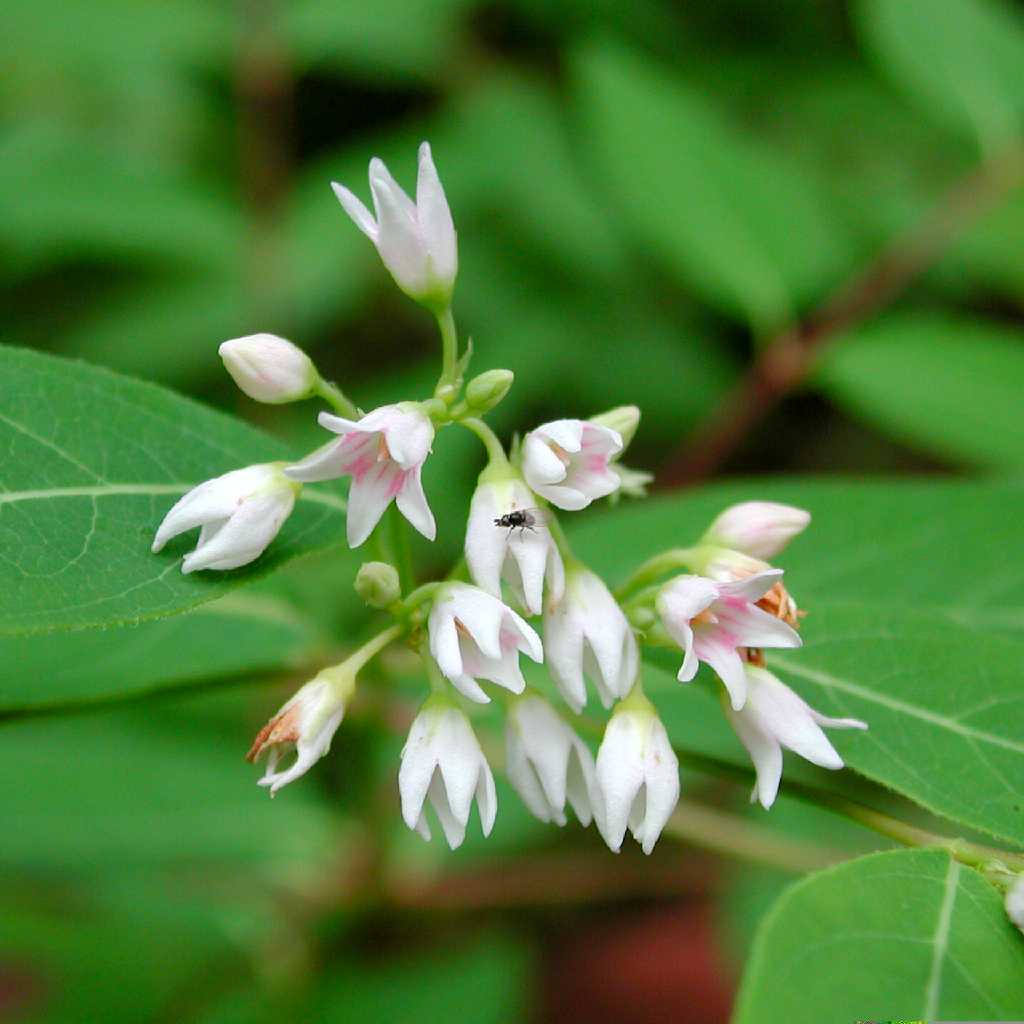Perennial herb 10 - 60 cm tall
Leaves: opposite, wide-spreading, ascending, or reflexed, on stalks with glands in or above the axils. The blades are dark green (but paler on underside), firm, 3 - 8 cm long, elliptic to more oblong-egg-shaped, with an abruptly pointed spine-tip, non-toothed edges, and possibly some hair on the underside, though hairless above.
Inflorescence: of individually stalked, ascending, spreading, or sometimes slightly nodding flowers in terminal, fairly elongate, branched clusters. The inflorescence clusters often surpass the leaves and lateral branches in height.
Flowers: white often with pink tinges, 4 - 7 mm long, 3.5 - 6 mm wide, radially symmetric, bell- to urn-shaped, and quite fragrant.
Sepals: five, but fused at base, then separating into triangular, pointed lobes, which are less than, or only up to half the length of the petal tube.
Petals: five, but fused for most of their length, then separating into very short, spreading lobes, with the petals overall under two-and-a-half times longer than the sepals. Inside, near the base of the petal tube, and opposite each lobe, is a tooth or scale.
Stamens: five, with separate, short filaments attached to the inside of the petal tube, but the lance-triangular-shaped anthers fused together, surrounding and connected to the stigma, and prolonged beyond the stigma into a cone.
Pistil: with two, superior ovaries, which are subtended by five nectaries, but the two ovaries sharing a single style and stigma.
Fruit: of two, dry, single-chambered, many-seeded, 5 - 15 cm long, elongate, slender, spindle-shaped (with gradually narrowed ends), capsule-like pods (follicles), which open lengthwise by a single seam.
Stems: ascending or spreading, unbranched or branched, tough, fibrous, and exuding a milky, acrid juice or latex sap when cut or broken.
Seeds: numerous, 3 - 4 mm long, narrowly elliptic to sickle-shaped, with a conspicuous tuft of 1 - 2 cm long hairs (coma) at one end.
Similar species: Apocynum x floribundum is probably most easily confused with one of its parent species, A. androsaemifolium, since both have pinkish flowers, but A. androsaemifolium has larger flowers (0.6 - 1 cm long, 0.5 - 1 cm wide), the petal lobes recurve, the flowers usually droop, and there are usually some axillary inflorescences in addition to the terminal inflorescences. Also very similar are the other possible parents of this hybrid, A. cannabinum and A. sibiricum, but the flowers of those species are greenish white and normally not over 0.5 cm long; the inflorescence is broader, not elongate, and usually surpassed in height by sterile lateral branches; the leaves are ascending or wide-spreading, but never drooping; and the hairs of the seeds are often over 2 cm long.
Flowering: June to early August
Habitat and ecology: Quite infrequent, mostly in open woods, prairies, and swales.
Occurence in the Chicago region: native
Notes: This hybrid complex can form by the crossing of A. androsaemifolium with A. cannabinum, A. sibiricum, or even both species. There is much variation, but in general many of the characters are intermediate between the parent species. Many sources refer to this hybrid under the name A. x medium.
Author: The Field Museum
Duration: Perennial
Nativity: Native
Lifeform: Forb/Herb
General: Erect to ascending stems, 20-50 cm tall, glabrous and branched, these mostly opposite, dichotomously branched below.
Leaves: Opposite, petiolate to subsessile, glabrous above to hairy or puberulent below, mostly spreading, ovate to oblong-lanceolate, 5-10 cm long and 0.5-2.5 cm wide, on petioles 2-4 mm long.
Flowers: Terminal and axillary cyme, the calyx lobes mostly lanceolate, 1.5-3 mm long, the corolla white, 4 mm long, cylindrical to campanulate the lobes erect to spreading, white or with pinkish veins.
Fruits: Narrow follicles 7-15 cm long, pendulous at maturity.
Ecology: Found in open, often disturbed habitats, often in mixed deciduous woodlands from 1,500-7,500 ft (457-2286 m), flowers May-August.
Distribution: Ranges throughout North America and north to Canada.
Notes: This is a hybrid that is considered to be halfway between A. androsaemifolium and A. cannabinum.
Ethnobotany: Used ceremonially, as an emetic, strips were used for thatch, braided and used as cordage and belts.
Etymology: Apocynum is from Greek apo, away from, and kyon dog, hence dogbane, while floribundum means having many flowers.
Synonyms: None
Editor: SBuckley, 2011








